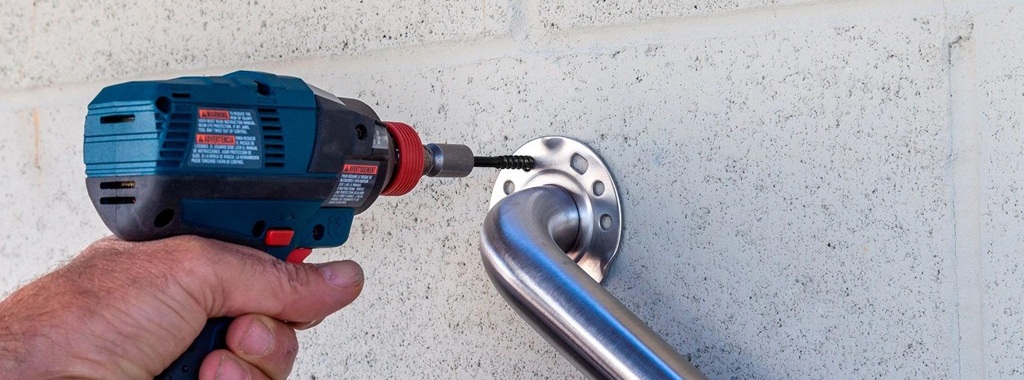Discover the innovation driving our Titen Turbo concrete screw anchors. In the following post, Ken Cho, Senior Product Engineer at Simpson Strong-Tie, explains how the patented dust channel design simplifies installations, eliminates frustrations and enhances overall efficiency. Revolutionize your concrete fastening projects with our latest offering — now also available in black!
If you have experience installing a post-installed mechanical anchor, you know that blowing the dust out of the drilled hole prior to installing anchor is an essential step in many manufacturers’ product installation instructions (MPII). This is true for our Strong-Bolt® 2 wedge anchor and Titen HD® screw anchor. While blowing the dust out of the hole may not seem like a difficult step in the installation process, those with experience also know that the smaller the hole gets, the more difficult it is to evacuate the dust properly. Readily available blowguns are typically 1/4″ in diameter, so cleaning holes equal to or smaller than 1/4″ in diameter will require a specially devised tip for a blowgun to reach the bottom of the drilled hole. Our Titen Turbo™ concrete and masonry screws are available in 3/16″ and 1/4″ diameters and require holes to be drilled with carbide diameters of 5/32″ and 3/16″ respectively, which is common for these small screws.
The good news is that the Titen Turbo comes with a patented dust channel thread design which eliminates the need to clean holes entirely. If you take a look at MPII for the Titen Turbo, you’ll notice it’s an easy two-step process to secure a fixture using the Titen Turbo — just drill and drive. There’s no cleaning required between those two steps, minimizing the overall time for installation while also reducing the amount of equipment (compressed air) needed to bring to a jobsite to complete the project.

The dust channel is a feature visible with the naked eye. If you look closely at the anchor body between the threads, you will notice the body is concave instead of a typical straight line. This concave geometry displaces dust as you drive Titen Turbo into a hole.
The dust channel design was born out of an R&D brainstorming session focused on the customer experience and making the installation of a concrete screw anchor as easy as possible. Several different design ideas came out of this brainstorming session, but the dust channel was the one that looked like it could have the greatest impact for our customers. This is because one of the biggest problems with installing a small concrete screw anchor is having the screw snap before it’s fully seated. This often happens when the screw binds up in the hole from jamming so much dust between the threads that the screw can no longer move forward in the hole. By providing a channel between the threads to accommodate some of the displaced dust, the Titen Turbo minimizes the incidence of screws breaking during installation. During the development of this product, several different prototype iterations were tested in order to zero in on the best geometry to balance easy installation with screw strength. The prototypes were tested rigorously in our state-of-the-art concrete anchor test lab to make sure all contingencies were addressed in the design. Hundreds of anchors were driven into various substrates by many different people with varying amounts of construction experience in order to verify the best design. Once we were satisfied with the performance, the design was finalized and a patent application was filed to protect it. That patent was issued in 2021 as US Patent 11,002,305.

As for common applications, the Titen Turbo™ screw anchor is often used in attaching window frames, door tracks, and furring strips to backing materials. The serrated screw point of the Titen Turbo is especially helpful in providing easier starts when fastening wood.

Yet, while the most common uses may be in light-duty applications, the load ratings are backed by testing. The Titen Turbo is tested in accordance with ACI 355.2 and ICC-ES Acceptance Criteria AC193 in uncracked concrete and code listed in IAPMO UES ER-712 for concrete. It has also been tested in accordance with ICC-ES AC106 in masonry and is listed in ER-716 for grouted and ungrouted masonry applications. These listings may come in handy when your project requires you to use code-listed products.

The Titen Turbo applications are included in our free Anchor Designer™ software for concrete. This software can assist you in performing strength design calculations in accordance with ACI 318-19 in concrete. If prescriptive design load values are desired, we offer a technical bulletin, TEB-A-TNT24, where load values for single anchors are displayed in tables.

For flexibility, Titen Turbo screw anchors come in a variety of lengths, three head styles, and four colors. Hex head is the most common head style; however, flat and trim head styles are also available when a flush installation is desired. For colors, we offer Titen Turbo in blue, white, silver, bronze and now black . The black Titen Turbo is offered in both 3/16″ and 1/4″ diameters with hex and flat head styles. It’s available in lengths up to 4″.
For more about the Titen Turbo, visit our product page.
You can also watch this video for quick Titen Turbo installation instructions.




